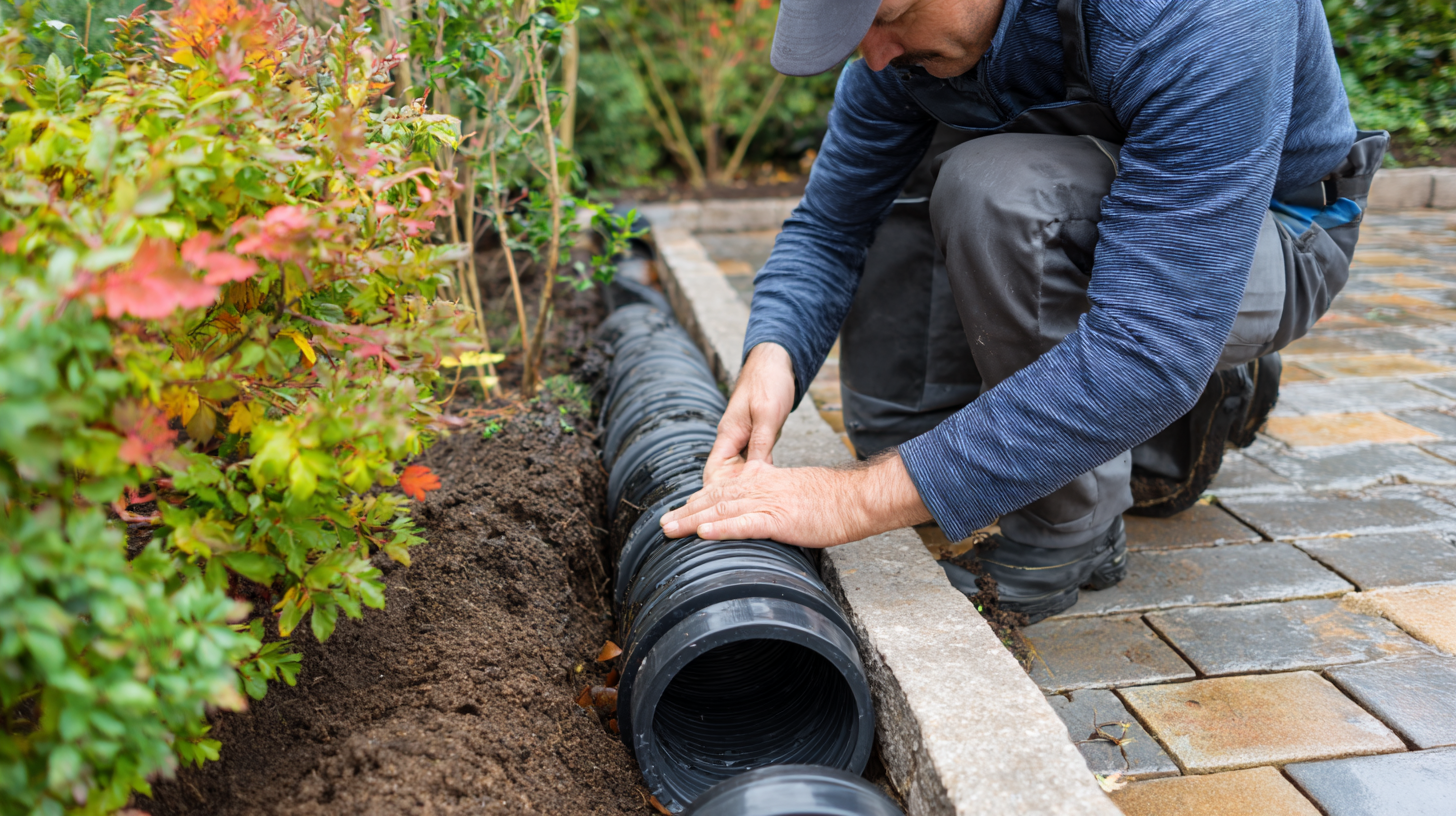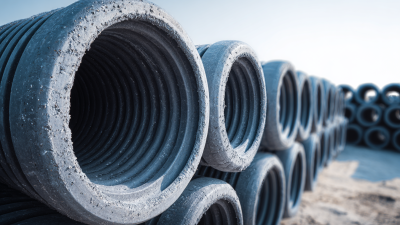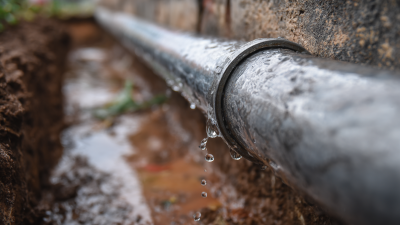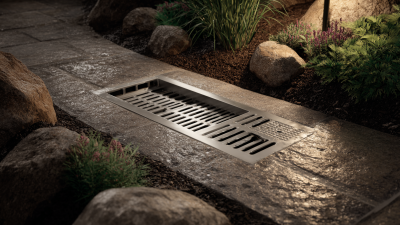Choosing the right outdoor drainage pipe is crucial for maintaining the integrity of your landscape and ensuring proper water management. According to a report by the American Society of Civil Engineers, over 50% of urban infrastructure failures can be attributed to inadequate drainage systems, highlighting the importance of effective outdoor drainage solutions. Proper drainage can prevent soil erosion, reduce flooding risks, and protect your ornamental gardens, lawns, and hardscapes. With a wide variety of materials and systems available, making informed selections based on factors such as soil composition, climate conditions, and the specific needs of your landscape is essential.

This comprehensive guide will help you navigate the complexities of outdoor drainage pipe options, giving you the knowledge to make a decision that enhances both the functionality and aesthetics of your outdoor spaces.
When selecting the best outdoor drainage pipe for your landscape, it's essential to understand the various types available and their specific applications.
The two most common types are PVC (Polyvinyl Chloride) and corrugated drainage pipes.
According to a report by the American Society of Civil Engineers, approximately 50% of all drainage systems use PVC due to its durability and resistance to corrosion, making it suitable for both residential and commercial applications.
PVC pipes are rigid, which helps maintain their shape under pressure but may require additional fittings and couplings.
On the other hand, corrugated pipes are often favored for their flexibility and ease of installation.
A study published in the Journal of Irrigation and Drainage Engineering indicates that corrugated pipes can reduce construction time by up to 30% when installed in complex landscape layouts.
These pipes are typically used in areas where water drainage is highly variable, as their ability to expand and contract helps manage flow effectively.
Ultimately, understanding the advantages and disadvantages of each type of pipe will allow homeowners and landscape designers to make informed choices tailored to their specific drainage needs.
When selecting outdoor drainage pipes for landscaping, it is essential to consider several key factors to ensure effectiveness and durability. One major consideration is the type of material used for the drainage pipes. PVC pipes, widely recognized for their strength and corrosion resistance, are a prominent choice in the construction and drainage sectors. The global PVC pipe market is projected to witness substantial growth, with the demand driven by its various applications, including pressure pipes, drainage systems, and electrical conduits. In specific categories, such as PVC Schedule 40 and Schedule 80 pipes, the market showcases a healthy increase in usage due to their robust and versatile nature.
Another critical aspect to weigh when selecting drainage pipes is their application. For instance, DWV (Drainage, Waste, and Vent) PVC pipes are specifically designed for the efficient management of wastewater, while PVC drainage tiles provide an effective solution for surface water management in landscapes. Understanding the nuances of each pipe type, such as load capacity, flexibility, and installation ease, will help homeowners and landscapers make informed decisions. Moreover, with climate change exacerbating extreme weather conditions, selecting the right drainage system is more crucial than ever to maintain the integrity of landscapes and structures.
| Pipe Material | Durability | Cost Per Foot | Ease of Installation | Best Application |
|---|---|---|---|---|
| PVC | High | $0.50 - $1.00 | Easy | Residential use, non-pressurized systems |
| HDPE | Very High | $1.00 - $1.50 | Moderate | Agricultural and industrial applications |
| Corrugated Metal | Moderate | $2.00 - $3.00 | Difficult | Heavy-duty drainage and erosion control |
| Cast Iron | Very High | $3.00 - $5.00 | Difficult | Commercial and heavy industrial systems |
When installing an outdoor drainage system, avoiding common mistakes can save homeowners from costly repairs and maintenance. One prevalent error is neglecting to choose the right type of drainage pipe. According to industry experts, using a pipe that is not suited for the specific soil and landscape conditions can lead to clogs and water buildup, which defeats the purpose of the drainage system. For instance, plastic pipes may crack in freezing temperatures, whereas metal pipes can corrode, reducing their lifespan and efficiency.
Another critical mistake is improper grading. Studies show that a slope of at least 1% is recommended to ensure effective water flow away from the foundation. However, many installations fail to meet this standard, leading to stagnant water and potential flooding during heavy rains. Homeowners should also be cautious about overlooking potential blockage from tree roots and debris. Regular maintenance is essential; neglecting this can significantly hinder the drainage system's performance and lead to extensive landscape damage. Understanding these pitfalls can ensure a more efficient and long-lasting drainage system.

Maintaining your outdoor drainage system is crucial for the longevity and effectiveness of your landscape. To start, regular inspections should be a priority. Check for any debris that might clog the pipes, such as leaves, twigs, or dirt. Clearing these blockages promptly can prevent water from pooling in unwanted areas, which could lead to erosion or even damage to your plants. It’s wise to schedule these checks seasonally, ensuring your system is prepared for rain and snowmelt.
Another essential tip is to ensure that your drainage pipes are properly sloped. This encourages efficient water flow and prevents stagnant water, which can lead to unpleasant odors and pest problems. Additionally, consider incorporating maintenance products designed for drainage systems; these can help breakdown organic materials that accumulate over time. Lastly, if your landscape is subject to heavy rainfall, investing in sump pumps or French drains can be beneficial. These systems work in tandem with your drainage pipes, providing extra assurance that your landscape remains dry and healthy.
When selecting outdoor drainage solutions, climate plays a pivotal role in determining the best choices for your landscape. Different regions experience varying levels of precipitation, humidity, and temperature fluctuations, which directly influence the type of drainage system required. For instance, areas prone to heavy rainfall or flooding necessitate robust drainage solutions, such as larger pipes and more efficient grading, to redirect water flow effectively and prevent erosion. In contrast, regions with minimal rainfall may benefit from simpler, less extensive systems, focusing on optimal water retention and soil health.

Additionally, temperature variations can affect the materials used for drainage pipes. In colder climates, plastic pipes may become brittle, while metal pipes may corrode over time due to freeze-thaw cycles. This necessitates choosing durable materials suitable for local conditions to ensure longevity and functionality. Understanding how climate interacts with drainage needs can help homeowners create a resilient landscape that remains functional and aesthetically pleasing, regardless of the weather challenges faced.






